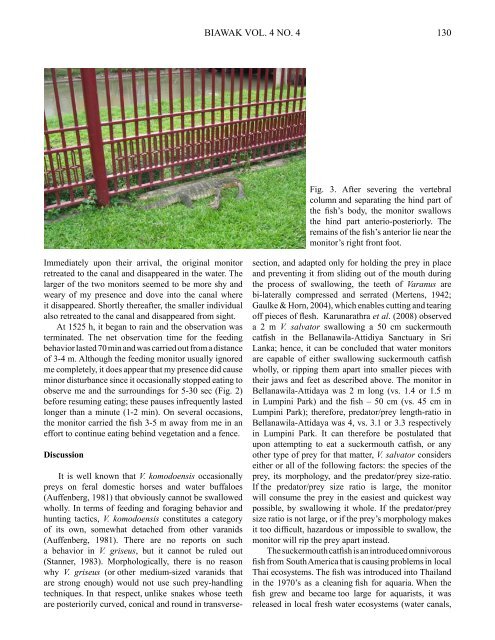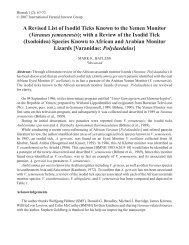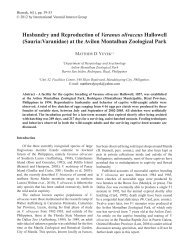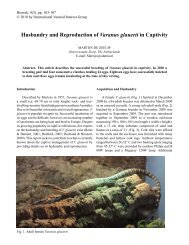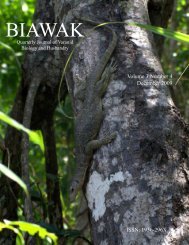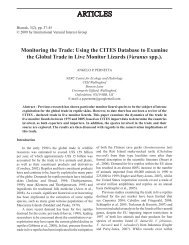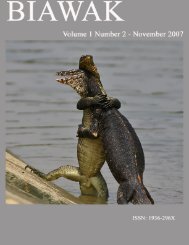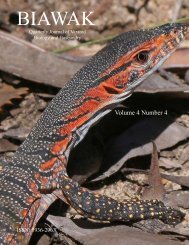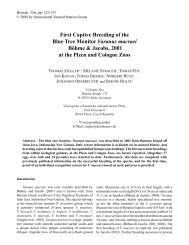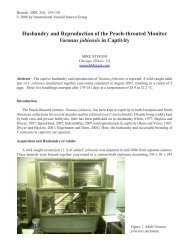BIAWAK - International Varanid Interest Group
BIAWAK - International Varanid Interest Group
BIAWAK - International Varanid Interest Group
- No tags were found...
Create successful ePaper yourself
Turn your PDF publications into a flip-book with our unique Google optimized e-Paper software.
<strong>BIAWAK</strong> VOL. 4 NO. 4<br />
130<br />
Fig. 3. After severing the vertebral<br />
column and separating the hind part of<br />
the fish’s body, the monitor swallows<br />
the hind part anterio-posteriorly. The<br />
remains of the fish’s anterior lie near the<br />
monitor’s right front foot.<br />
Immediately upon their arrival, the original monitor<br />
retreated to the canal and disappeared in the water. The<br />
larger of the two monitors seemed to be more shy and<br />
weary of my presence and dove into the canal where<br />
it disappeared. Shortly thereafter, the smaller individual<br />
also retreated to the canal and disappeared from sight.<br />
At 1525 h, it began to rain and the observation was<br />
terminated. The net observation time for the feeding<br />
behavior lasted 70 min and was carried out from a distance<br />
of 3-4 m. Although the feeding monitor usually ignored<br />
me completely, it does appear that my presence did cause<br />
minor disturbance since it occasionally stopped eating to<br />
observe me and the surroundings for 5-30 sec (Fig. 2)<br />
before resuming eating; these pauses infrequently lasted<br />
longer than a minute (1-2 min). On several occasions,<br />
the monitor carried the fish 3-5 m away from me in an<br />
effort to continue eating behind vegetation and a fence.<br />
Discussion<br />
It is well known that V. komodoensis occasionally<br />
preys on feral domestic horses and water buffaloes<br />
(Auffenberg, 1981) that obviously cannot be swallowed<br />
wholly. In terms of feeding and foraging behavior and<br />
hunting tactics, V. komodoensis constitutes a category<br />
of its own, somewhat detached from other varanids<br />
(Auffenberg, 1981). There are no reports on such<br />
a behavior in V. griseus, but it cannot be ruled out<br />
(Stanner, 1983). Morphologically, there is no reason<br />
why V. griseus (or other medium-sized varanids that<br />
are strong enough) would not use such prey-handling<br />
techniques. In that respect, unlike snakes whose teeth<br />
are posteriorily curved, conical and round in transversesection,<br />
and adapted only for holding the prey in place<br />
and preventing it from sliding out of the mouth during<br />
the process of swallowing, the teeth of Varanus are<br />
bi-laterally compressed and serrated (Mertens, 1942;<br />
Gaulke & Horn, 2004), which enables cutting and tearing<br />
off pieces of flesh. Karunarathra et al. (2008) observed<br />
a 2 m V. salvator swallowing a 50 cm suckermouth<br />
catfish in the Bellanawila-Attidiya Sanctuary in Sri<br />
Lanka; hence, it can be concluded that water monitors<br />
are capable of either swallowing suckermouth catfish<br />
wholly, or ripping them apart into smaller pieces with<br />
their jaws and feet as described above. The monitor in<br />
Bellanawila-Attidaya was 2 m long (vs. 1.4 or 1.5 m<br />
in Lumpini Park) and the fish – 50 cm (vs. 45 cm in<br />
Lumpini Park); therefore, predator/prey length-ratio in<br />
Bellanawila-Attidaya was 4, vs. 3.1 or 3.3 respectively<br />
in Lumpini Park. It can therefore be postulated that<br />
upon attempting to eat a suckermouth catfish, or any<br />
other type of prey for that matter, V. salvator considers<br />
either or all of the following factors: the species of the<br />
prey, its morphology, and the predator/prey size-ratio.<br />
If the predator/prey size ratio is large, the monitor<br />
will consume the prey in the easiest and quickest way<br />
possible, by swallowing it whole. If the predator/prey<br />
size ratio is not large, or if the prey’s morphology makes<br />
it too difficult, hazardous or impossible to swallow, the<br />
monitor will rip the prey apart instead.<br />
The suckermouth catfish is an introduced omnivorous<br />
fish from South America that is causing problems in local<br />
Thai ecosystems. The fish was introduced into Thailand<br />
in the 1970’s as a cleaning fish for aquaria. When the<br />
fish grew and became too large for aquarists, it was<br />
released in local fresh water ecosystems (water canals,


